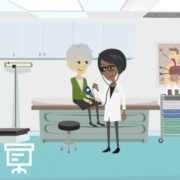An Overview of ET, PV and MF Treatment Options from Patient Empowerment Network on Vimeo.
Treatment for essential thrombocythemia (ET), polycythemia vera (PV), and myelofibrosis (MF) can vary greatly. Dr. John Mascarenhas breaks down the treatment types and the goals of treatment for each type of myeloproliferative neoplasm (MPN).
Dr. John Mascarenhas is Associate Professor of Medicine at the Icahn School of Medicine at Mount Sinai (ISMMS) and the Director of the Adult Leukemia Program and Leader of Clinical Investigation within the Myeloproliferative Disorders Program at Mount Sinai. Learn more about Dr. Mascarenhas, here.
See More from INSIST! MPNs
Download Guide
Related Programs
Transcript
Katherine Banwell:
Depending on the patient, it seems like ET or PV may be easily managed. So, how are they treated? Let’s start with essential thrombocythemia or ET.
Dr. Mascarenhas:
So, ET is a disease in which first and foremost, we’re trying to reduce the risk of thrombosis, clotting, and/or hemorrhage bleeding. So, typically, ET patients are risk stratified by low risk or high risk.
It’s almost simply based on their age, whether they’ve had a clot in the past, and some systems now even incorporate other factors like mutation status. And, you tailor the treatment based on their risk score. So, low risk ET patients don’t necessarily need to be treated. They can be followed expectantly and watched. The height of the platelet count does not predict thrombotic risk. So, we don’t treat the platelet count per se. A high-risk patient is at high risk for clotting. So, these patients almost invariably are getting aspirin at a baseline, and they are often on cytoreductive therapy. And sometimes, that is chemotherapy like hydroxyurea. Sometimes it’s a non-chemotherapeutic option and like anagrelide, and sometimes it’s a biologic therapy like interferon alfa either 2a, Pegasys, or 2b ropeginterferon. And, these are therapies that have rationale, that have clinical data, that have demonstrated reduction in risk of clotting, which again is the reason why we treat high-risk ET patients.
Katherine Banwell:
And, what about PV, polycythemia vera?
Dr. Mascarenhas:
So, in polycythemia vera, it’s similar to ET. We risk stratify patients low and high risk based on age and clotting histories. And whether you’re low or high risk, we give PV patients aspirin or at least once daily, and we look to keep their hematocrit below a threshold of 45 percent. And sometimes in women, we even go lower, to 42 percent. But the idea is that controlling the hematocrit, which is one of the red blood cells indices, you reduce the risk of having clots, and that’s been shown actually many years ago and reinforced in a very well-known study called the CYTO-PV study in Italy documented that if you keep the hematocrit less than 45 percent, so, stringent control versus allowing for less stringent control between 45 to 50, that you reduce by fourfold the number of cardiovascular events that can occur.
So, we know that controlling the hematocrit is important, and that can be done, again, with hydroxyurea, interferon, and ruxolitinib.
The JAK2 inhibitor has also proved specifically for patients who had an intolerance or refractory hydroxyurea, but also importantly as a drug that can address, probably better than most drugs in this field, the symptom burden that could be problematic for some of those patients. But, it’s really about controlling the hematocrit.
Katherine Banwell:
Yeah. Since myelofibrosis is a progressive condition, I imagine that makes it more difficult to manage. So, what else is available for patients with myelofibrosis?
Dr. Mascarenhas:
The first line of treatment is typically a JAK inhibitor, although I would say that there are a subset of patients – well, there are patients we sometimes meet that have very low risk disease. They don’t have those clinical variables we discussed before that could uptick their risk score, and some of those patients can be watched.
And interestingly, there are a subset of patients that can have an indolent or slow form of the disease where they don’t have aggressive changes in their disease, their blood counts, their symptoms, their spleen, and don’t need immediate treatment. Most patients would benefit from a JAK inhibitor, although there are a subset of patients where their issue is less simple in spleen burden and it’s more anemia.
So, we take those patients where anemia’s the focus, we look at their erythropoietin level, which is their endogenous hormone level that regulates red blood cell production. If it’s low, we give them a lab-based form of erythropoietin, something called Procrit or Aranesp. If it’s high, we will move on. We can use a drug called danazol, which is a synthetic male androgen which can improve hemoglobin levels in 20 to 40 percent of patients. Or, we can use a drug called lenalidomide, which is an immunomodulatory drug. And, more recently, there’s a drug in testing called to luspatercept, which is an active activin receptor ligand trap. So, there is a growing armamentarium of drugs that can be used to try to alleviate the anemia which is present and can be a significant issue in about a quarter of patients with myelofibrosis upfront at time of diagnosis or about 75 percent through the course of their disease. So, that’s an unmet need that still requires attention and may alter the treatment plan for a given patient.
Katherine Banwell:
What about stem cell transplants?
Dr. Mascarenhas:
So, we relegate stem cell plant transplants for those patients as mentioned before that are higher risk because we think that the potential benefit-to-risk ratio is in favor of transplant.
Transplant is really a modality that is the only modality that offers the potential for cure, but it’s also a modality that poses a significant risk of morbidity and mortality associated with it. So, it has to really be taken very seriously. It can’t be the kind of treatment you would think of as a last resort at the last minute. Once you see a transplanter, if they’re interested in that therapy and see it early on in the disease course, in my opinion, to start that dialog and then figure out when is the optimal time to employ a bone marrow transplant, which is not a surgical procedure. It’s often thought to be surgical. It’s not a transplant of an organ. It’s a transplant of hematopoietic cells. So, it’s really an infusion of stem cells that then end up in the person’s bone marrow, and they create a whole new hematopoietic system and immune system. And with that, you can have an immune system that then goes after the myelofibrosis stem cells.
That’s called graft-versus-leukemia effect. But with that included graft-versus-host disease, which is when the new graft, the new immune system doesn’t always recognize well the person’s own tissues, whether it’s the liver, or the lung, or the skin, and you can have immunologic reactions to that.
So, that’s a complex discussion. But, transplant, typically for patients less than 70 years of age who have high-risk myelofibrosis or even up to 75 if they have a good performance status and as we said don’t have a lot of comorbid issues with a goal of cure. So, if you have someone where their goal is to try to maximize their time out of the hospital and they’re not focused on longevity, their focused on quality of life, that may not be an appropriate patient for transplantation.
So, I think a very upfront, honest and a transparent discussion with the patient about what to expect with transplant, what are the pros and cons, what are the risks involved, and importantly does it match up with their expectations or their desires.





























